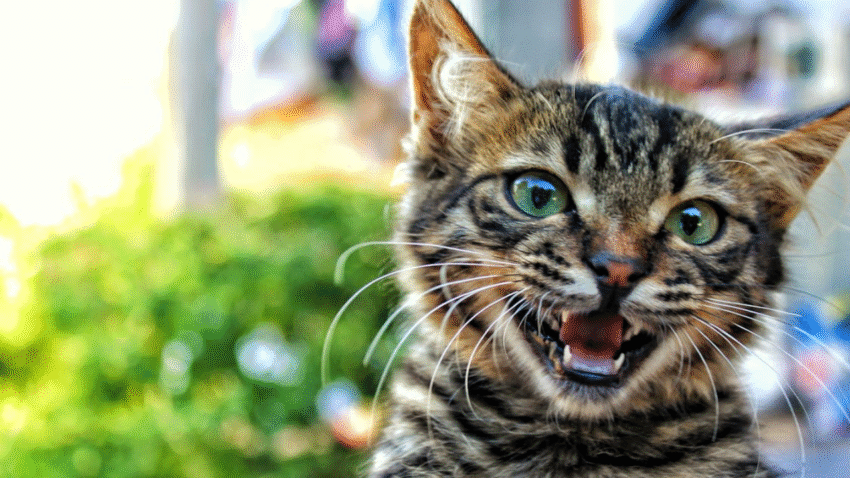Introduction
Ever wonder what your cat is trying to tell you with a flick of their tail or a slow blink? Cats may not speak our language, but they communicate volumes through body language. In this guide, you’ll learn how to understand and respond to your cat’s body language to build a stronger bond, avoid misunderstandings, and keep your feline friend happy and stress-free.
Why Cat Body Language Matters
Understanding your cat’s body language helps you connect with them on a deeper level. It also lets you:
- Recognize when your cat feels scared, playful, or relaxed
- Respond appropriately to signs of stress or aggression
- Avoid actions that make your cat uncomfortable
- Improve your cat’s trust and overall behavior
Cats use subtle cues, and missing them can lead to behavioral problems or even aggression. Learning to “speak cat” makes you a more attentive, compassionate cat owner.
Step-by-Step Guide to Reading Your Cat’s Body Language
1. Start With the Tail
A cat’s tail can reveal a lot about their mood:
- Straight up with a slight curve at the top: Friendly and happy to see you
- Puffed-up tail: Frightened or startled
- Low or tucked tail: Scared or submissive
- Tail flicking or thumping: Annoyed or overstimulated
- Tail wrapped around you: Affection and bonding
How to respond:
If the tail is flicking, back off or stop petting. If it’s upright and relaxed, it’s a good time to interact.
2. Watch the Ears
Ears are like mood radar for cats:
- Ears forward: Curious or alert
- Ears slightly to the side: Relaxed
- Ears turned back or flattened: Fear, irritation, or aggression
- Rapid ear twitching: Overstimulation or discomfort
How to respond:
Flattened ears are a clear sign to give your cat space. Forward ears often mean they’re interested in their surroundings or ready to play.
3. Observe the Eyes
A cat’s eyes are expressive, even if they don’t blink like we do:
- Slow blinking: A sign of trust and affection
- Wide eyes with dilated pupils: Excited, playful, or startled
- Narrow pupils: Focused or potentially agitated
- Avoiding eye contact: Nervous or submissive
How to respond:
Return your cat’s slow blink — it’s like a kitty “I love you.” Avoid staring into their eyes, which can be seen as a threat.
4. Check the Whiskers
Though subtle, whisker position can signal emotions:
- Whiskers relaxed and to the side: Calm
- Whiskers forward: Excited or alert
- Whiskers pulled back: Anxious or fearful
How to respond:
Use this in combination with other cues. Forward whiskers during play? They’re having fun. Forward whiskers during grooming? They might be overstimulated.
5. Look at the Body Posture
Full-body posture gives you the most context:
- Standing tall with tail up: Confident and friendly
- Crouched low to the ground: Nervous or hunting
- Arched back with fur raised: Scared or defensive
- Lying on side or back with exposed belly: Relaxed (but not always an invitation to touch)
- Stiff and frozen: Alert or fearful
How to respond:
A relaxed body is your green light for petting or play. A stiff, arched, or tense body means slow down or back away.
Common Cat Behaviors and What They Mean
1. Kneading
What it means: Comfort-seeking behavior, often a leftover from kittenhood
Your response: Let them knead if they’re relaxed. Use a blanket if their claws are sharp.
2. Head Butting (Bunting)
What it means: Affection and marking you with scent
Your response: Accept the love — it’s a compliment!
3. Hiding
What it means: Feeling threatened, stressed, or unwell
Your response: Give them space and make their environment calmer. Check in with a vet if it persists.
4. Chattering or Chirping
What it means: Excitement, often when watching prey
Your response: Provide interactive toys to simulate hunting and mental stimulation.
5. Belly Exposure
What it means: Relaxation — but not always an invite to touch
Your response: Pet only if you know your cat enjoys belly rubs. Otherwise, admire but don’t engage.
Common Mistakes to Avoid
1. Misreading a Belly Show as a Pet Invitation
Not all exposed bellies mean “rub here.” Many cats roll onto their backs when relaxed — not when they want touch.
2. Ignoring Warning Signs
Tail flicking, flattened ears, and narrowed eyes mean your cat is uncomfortable. Respect these signals to avoid scratches or bites.
3. Forcing Interaction
Trying to pick up or pet your cat when they’re showing signs of stress can damage trust. Let your cat initiate affection.
4. Overstimulating During Petting
Some cats enjoy short petting sessions. If your cat suddenly turns or swats, they’ve had enough — stop before that point.
5. Assuming All Cats Communicate the Same
Every cat is unique. Learn your cat’s personal signals and preferences over time.
Extra Tips & Recommendations
- Practice the Slow Blink: Try blinking slowly at your cat when they’re calm. It builds trust and mimics feline affection.
- Use Body Language to Communicate Back: Lower your posture, avoid direct eye contact, and move slowly to appear non-threatening.
- Create a Safe Space: Give your cat hiding spots, vertical shelves, or quiet rooms where they can decompress.
- Use Positive Reinforcement: Reward calm body language with treats, praise, or play to reinforce trust.
Conclusion
Understanding your cat’s body language is like learning a new language — one built on subtle signs and signals. By paying close attention to their tail, ears, eyes, and posture, you can meet your cat’s needs more effectively and build a deeper, more respectful bond. Remember, each cat is different, so the key is observation, patience, and love. With time, you’ll become fluent in “cat.” 🐾
